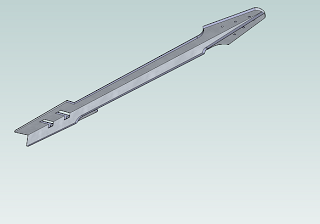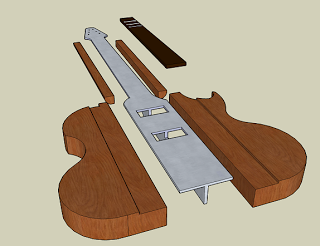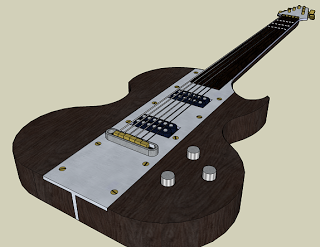Guitar
Over the last years, I've become more and more interested in building guitars rather than (just) playing them. I never got around to actually building anything, but I took a couple of guitars apart and put them together again. I also discovered, that people build guitars in aluminium (or aluminum, if you prefer). They sound great. I'd like to have one, but they're prohibitively expensive.
One evening a couple of months ago, when i was looking at metalnecks.com, which links to a lot of aluminium guitars, it struck me that the majority of guitars have wooden bodies with aluminium necks or aluminium bodies with wooden necks. There were comparably few one-piece aluminium guitars. And no aluminium "neck-through"-necks with attached wooden "wings" at all. That puzzled me a bit, because it seems that among luthiers using wood, the neck-through design is widely considered the best overall solution.
I tried to imagine how an aluminium neck-through-neck would look. It might be made from a single long slab of aluminium. That would be very heavy, so you'd probably route out some of the material along the neck like the Kramer aluminium neck. Then you'd get something looking a lot like an aluminium T-beam. You know, these metal beams used for load bearing parts of houses among other things.
Why not use a stock T-beam? That'd be way cheaper than having the neck made from a big slab of aluminium on a CAM router. I think it can be done in the following steps.
You start out with at T-beam, which will act as sort of a spine in the guitar. A top flange of 100mm, a bottom flange of 60mm and 5 mm flange thickness (that will be approx 4, 2,4 and 0,2 inches) will be suitable. They are available, but - as it should turn out later - not exactly readily available.

The T-bar is cut to shape (Pickup holes, neck and head). Due to the width of the pickup holes, the T-bar has to be quite wide in order to keep its structural strength. With a narrower T-bar, the pickup holes would completely intersect the top flange, weakening the T-bar considerably.

Having modified the T-bar, you screw or glue on wings (like on a wooden neck-through guitar), fingerboard and some pieces of wood to give the neck its desired shape. Plus, of course, route out cavities for electronics, sand the body, mount bridge, nut, etc, etc.

This way, you get a guitar with a lot of structural strength from the T-beam. You have great freedom of choice of wood and shapes of the body. And best of all: It should be possible to do it with ordinary do-it-yourself tools (hand held router, metal saw, sand paper, electric drill, belt sander, etc.).
I think it will work. I think it will look amazing. I am not sure how it will sound, but I am going to build myself one. Then we shall see. Or rather hear.
I'll post updates on this blog. I've already done some designing and planning plus a couple of purchases. This will be described in separate posts in the near future, and I expect that when I get around to the actual construction of the thing, my posting will have caught up, and I'll be posting in more or less real-time.
- Two-layer Aluminium Neck
Among the drawbacks of my old T-beam designs were the lack of a truss rod or similar system to control the bow of the neck. A way to help this - but still use stock aluminium beam for the guitar - could be having a neck in two layers - an upper flat beam,...
- In The Meantime...
It's been a while since my last update. This is primarily due to other, more pressing tasks in life. I haven't done any work on the T-beam guitar, except from a lot of thinking. In the meantime, I've made a modification to my old Squier Strat....
- The Aluminium Bars Have Arrived
The flat bars of aluminium, which I ordered, have arrived. If I arrange them as a T-beam and add the other components I have already bought, it looks like this. The guitar is almost complete, right? All that's lacking is some wood. Not exactly. I...
- Making My Own T-beam
As mentioned earlier, I've had an unexpected hard time finding a suitable T-beam. There are lots of them available, but none wide enough for me to make holes for the pickups without intersecting the top flange completely. For now, I have given...
- A Different Tuner System For Headless Designs
The guitar I'm planning at the moment might be the first in a series. If it turns out well and the building process is fun (the planning sure is), I expect to build another one. And probably then another. And so on. If the guitar turns out sounding...
Guitar
Background - why and how
Over the last years, I've become more and more interested in building guitars rather than (just) playing them. I never got around to actually building anything, but I took a couple of guitars apart and put them together again. I also discovered, that people build guitars in aluminium (or aluminum, if you prefer). They sound great. I'd like to have one, but they're prohibitively expensive.
One evening a couple of months ago, when i was looking at metalnecks.com, which links to a lot of aluminium guitars, it struck me that the majority of guitars have wooden bodies with aluminium necks or aluminium bodies with wooden necks. There were comparably few one-piece aluminium guitars. And no aluminium "neck-through"-necks with attached wooden "wings" at all. That puzzled me a bit, because it seems that among luthiers using wood, the neck-through design is widely considered the best overall solution.
I tried to imagine how an aluminium neck-through-neck would look. It might be made from a single long slab of aluminium. That would be very heavy, so you'd probably route out some of the material along the neck like the Kramer aluminium neck. Then you'd get something looking a lot like an aluminium T-beam. You know, these metal beams used for load bearing parts of houses among other things.
Why not use a stock T-beam? That'd be way cheaper than having the neck made from a big slab of aluminium on a CAM router. I think it can be done in the following steps.
You start out with at T-beam, which will act as sort of a spine in the guitar. A top flange of 100mm, a bottom flange of 60mm and 5 mm flange thickness (that will be approx 4, 2,4 and 0,2 inches) will be suitable. They are available, but - as it should turn out later - not exactly readily available.
The T-bar is cut to shape (Pickup holes, neck and head). Due to the width of the pickup holes, the T-bar has to be quite wide in order to keep its structural strength. With a narrower T-bar, the pickup holes would completely intersect the top flange, weakening the T-bar considerably.
Having modified the T-bar, you screw or glue on wings (like on a wooden neck-through guitar), fingerboard and some pieces of wood to give the neck its desired shape. Plus, of course, route out cavities for electronics, sand the body, mount bridge, nut, etc, etc.
This way, you get a guitar with a lot of structural strength from the T-beam. You have great freedom of choice of wood and shapes of the body. And best of all: It should be possible to do it with ordinary do-it-yourself tools (hand held router, metal saw, sand paper, electric drill, belt sander, etc.).
I think it will work. I think it will look amazing. I am not sure how it will sound, but I am going to build myself one. Then we shall see. Or rather hear.
I'll post updates on this blog. I've already done some designing and planning plus a couple of purchases. This will be described in separate posts in the near future, and I expect that when I get around to the actual construction of the thing, my posting will have caught up, and I'll be posting in more or less real-time.
- Two-layer Aluminium Neck
Among the drawbacks of my old T-beam designs were the lack of a truss rod or similar system to control the bow of the neck. A way to help this - but still use stock aluminium beam for the guitar - could be having a neck in two layers - an upper flat beam,...
- In The Meantime...
It's been a while since my last update. This is primarily due to other, more pressing tasks in life. I haven't done any work on the T-beam guitar, except from a lot of thinking. In the meantime, I've made a modification to my old Squier Strat....
- The Aluminium Bars Have Arrived
The flat bars of aluminium, which I ordered, have arrived. If I arrange them as a T-beam and add the other components I have already bought, it looks like this. The guitar is almost complete, right? All that's lacking is some wood. Not exactly. I...
- Making My Own T-beam
As mentioned earlier, I've had an unexpected hard time finding a suitable T-beam. There are lots of them available, but none wide enough for me to make holes for the pickups without intersecting the top flange completely. For now, I have given...
- A Different Tuner System For Headless Designs
The guitar I'm planning at the moment might be the first in a series. If it turns out well and the building process is fun (the planning sure is), I expect to build another one. And probably then another. And so on. If the guitar turns out sounding...
